Yifeng Liu
On the Design of KL-Regularized Policy Gradient Algorithms for LLM Reasoning
May 23, 2025Abstract:Policy gradient algorithms have been successfully applied to enhance the reasoning capabilities of large language models (LLMs). Despite the widespread use of Kullback-Leibler (KL) regularization in policy gradient algorithms to stabilize training, the systematic exploration of how different KL divergence formulations can be estimated and integrated into surrogate loss functions for online reinforcement learning (RL) presents a nuanced and systematically explorable design space. In this paper, we propose regularized policy gradient (RPG), a systematic framework for deriving and analyzing KL-regularized policy gradient methods in the online RL setting. We derive policy gradients and corresponding surrogate loss functions for objectives regularized by both forward and reverse KL divergences, considering both normalized and unnormalized policy distributions. Furthermore, we present derivations for fully differentiable loss functions as well as REINFORCE-style gradient estimators, accommodating diverse algorithmic needs. We conduct extensive experiments on RL for LLM reasoning using these methods, showing improved or competitive results in terms of training stability and performance compared to strong baselines such as GRPO, REINFORCE++, and DAPO. The code is available at https://github.com/complex-reasoning/RPG.
R-PRM: Reasoning-Driven Process Reward Modeling
Mar 27, 2025Abstract:Large language models (LLMs) inevitably make mistakes when performing step-by-step mathematical reasoning. Process Reward Models (PRMs) have emerged as a promising solution by evaluating each reasoning step. However, existing PRMs typically output evaluation scores directly, limiting both learning efficiency and evaluation accuracy, which is further exacerbated by the scarcity of annotated data. To address these issues, we propose Reasoning-Driven Process Reward Modeling (R-PRM). First, we leverage stronger LLMs to generate seed data from limited annotations, effectively bootstrapping our model's reasoning capabilities and enabling comprehensive step-by-step evaluation. Second, we further enhance performance through preference optimization, without requiring additional annotated data. Third, we introduce inference-time scaling to fully harness the model's reasoning potential. Extensive experiments demonstrate R-PRM's effectiveness: on ProcessBench and PRMBench, it surpasses strong baselines by 11.9 and 8.5 points in F1 scores, respectively. When applied to guide mathematical reasoning, R-PRM achieves consistent accuracy improvements of over 8.5 points across six challenging datasets. Further analysis reveals that R-PRM exhibits more comprehensive evaluation and stronger generalization capabilities, thereby highlighting its significant potential.
A Survey of Zero-Knowledge Proof Based Verifiable Machine Learning
Feb 25, 2025



Abstract:As machine learning technologies advance rapidly across various domains, concerns over data privacy and model security have grown significantly. These challenges are particularly pronounced when models are trained and deployed on cloud platforms or third-party servers due to the computational resource limitations of users' end devices. In response, zero-knowledge proof (ZKP) technology has emerged as a promising solution, enabling effective validation of model performance and authenticity in both training and inference processes without disclosing sensitive data. Thus, ZKP ensures the verifiability and security of machine learning models, making it a valuable tool for privacy-preserving AI. Although some research has explored the verifiable machine learning solutions that exploit ZKP, a comprehensive survey and summary of these efforts remain absent. This survey paper aims to bridge this gap by reviewing and analyzing all the existing Zero-Knowledge Machine Learning (ZKML) research from June 2017 to December 2024. We begin by introducing the concept of ZKML and outlining its ZKP algorithmic setups under three key categories: verifiable training, verifiable inference, and verifiable testing. Next, we provide a comprehensive categorization of existing ZKML research within these categories and analyze the works in detail. Furthermore, we explore the implementation challenges faced in this field and discuss the improvement works to address these obstacles. Additionally, we highlight several commercial applications of ZKML technology. Finally, we propose promising directions for future advancements in this domain.
Tensor Product Attention Is All You Need
Jan 11, 2025Abstract:Scaling language models to handle longer input sequences typically necessitates large key-value (KV) caches, resulting in substantial memory overhead during inference. In this paper, we propose Tensor Product Attention (TPA), a novel attention mechanism that uses tensor decompositions to represent queries, keys, and values compactly, significantly shrinking KV cache size at inference time. By factorizing these representations into contextual low-rank components (contextual factorization) and seamlessly integrating with RoPE, TPA achieves improved model quality alongside memory efficiency. Based on TPA, we introduce the Tensor ProducT ATTenTion Transformer (T6), a new model architecture for sequence modeling. Through extensive empirical evaluation of language modeling tasks, we demonstrate that T6 exceeds the performance of standard Transformer baselines including MHA, MQA, GQA, and MLA across various metrics, including perplexity and a range of renowned evaluation benchmarks. Notably, TPAs memory efficiency enables the processing of significantly longer sequences under fixed resource constraints, addressing a critical scalability challenge in modern language models. The code is available at https://github.com/tensorgi/T6.
MARS: Unleashing the Power of Variance Reduction for Training Large Models
Nov 15, 2024
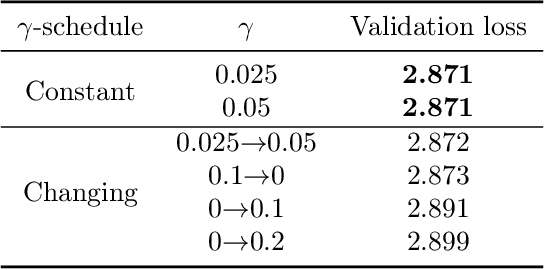


Abstract:Training deep neural networks--and more recently, large models--demands efficient and scalable optimizers. Adaptive gradient algorithms like Adam, AdamW, and their variants have been central to this task. Despite the development of numerous variance reduction algorithms in the past decade aimed at accelerating stochastic optimization in both convex and nonconvex settings, variance reduction has not found widespread success in training deep neural networks or large language models. Consequently, it has remained a less favored approach in modern AI. In this paper, to unleash the power of variance reduction for efficient training of large models, we propose a unified optimization framework, MARS (Make vAriance Reduction Shine), which reconciles preconditioned gradient methods with variance reduction via a scaled stochastic recursive momentum technique. Within our framework, we introduce three instances of MARS that leverage preconditioned gradient updates based on AdamW, Lion, and Shampoo, respectively. We also draw a connection between our algorithms and existing optimizers. Experimental results on training GPT-2 models indicate that MARS consistently outperforms AdamW by a large margin.
T-Rex: Text-assisted Retrosynthesis Prediction
Jan 26, 2024Abstract:As a fundamental task in computational chemistry, retrosynthesis prediction aims to identify a set of reactants to synthesize a target molecule. Existing template-free approaches only consider the graph structures of the target molecule, which often cannot generalize well to rare reaction types and large molecules. Here, we propose T-Rex, a text-assisted retrosynthesis prediction approach that exploits pre-trained text language models, such as ChatGPT, to assist the generation of reactants. T-Rex first exploits ChatGPT to generate a description for the target molecule and rank candidate reaction centers based both the description and the molecular graph. It then re-ranks these candidates by querying the descriptions for each reactants and examines which group of reactants can best synthesize the target molecule. We observed that T-Rex substantially outperformed graph-based state-of-the-art approaches on two datasets, indicating the effectiveness of considering text information. We further found that T-Rex outperformed the variant that only use ChatGPT-based description without the re-ranking step, demonstrate how our framework outperformed a straightforward integration of ChatGPT and graph information. Collectively, we show that text generated by pre-trained language models can substantially improve retrosynthesis prediction, opening up new avenues for exploiting ChatGPT to advance computational chemistry. And the codes can be found at https://github.com/lauyikfung/T-Rex.
UniRel: Unified Representation and Interaction for Joint Relational Triple Extraction
Nov 16, 2022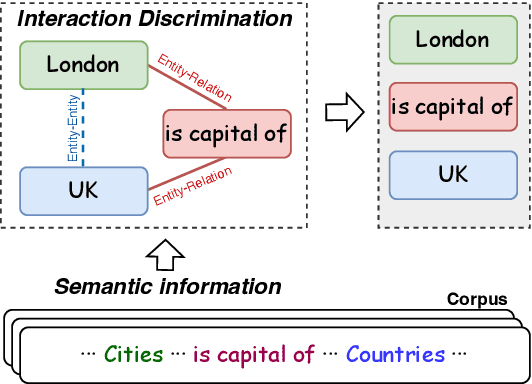
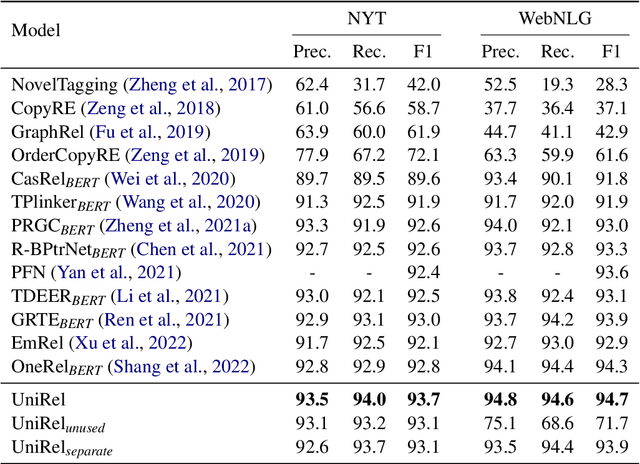
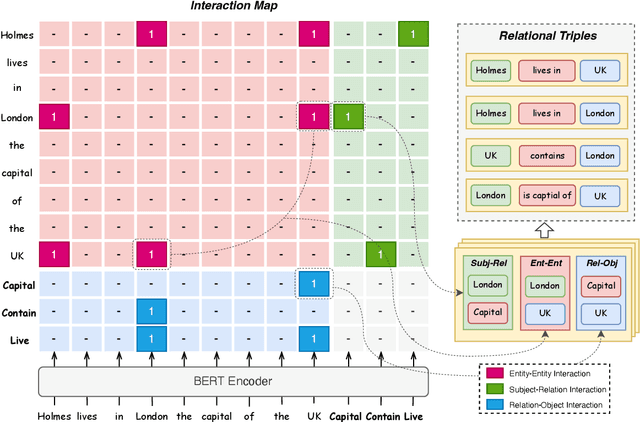
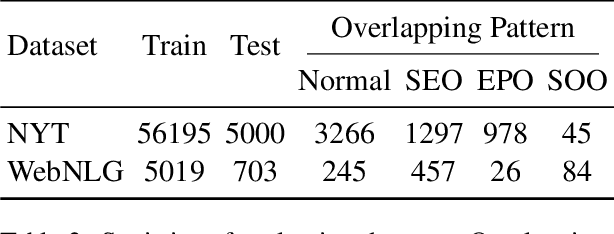
Abstract:Relational triple extraction is challenging for its difficulty in capturing rich correlations between entities and relations. Existing works suffer from 1) heterogeneous representations of entities and relations, and 2) heterogeneous modeling of entity-entity interactions and entity-relation interactions. Therefore, the rich correlations are not fully exploited by existing works. In this paper, we propose UniRel to address these challenges. Specifically, we unify the representations of entities and relations by jointly encoding them within a concatenated natural language sequence, and unify the modeling of interactions with a proposed Interaction Map, which is built upon the off-the-shelf self-attention mechanism within any Transformer block. With comprehensive experiments on two popular relational triple extraction datasets, we demonstrate that UniRel is more effective and computationally efficient. The source code is available at https://github.com/wtangdev/UniRel.
Progressive Multi-stage Interactive Training in Mobile Network for Fine-grained Recognition
Dec 08, 2021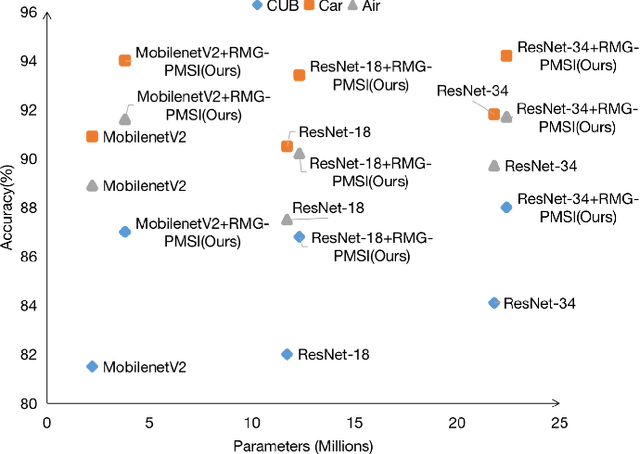
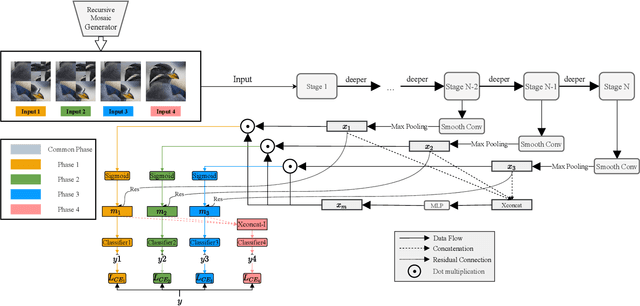
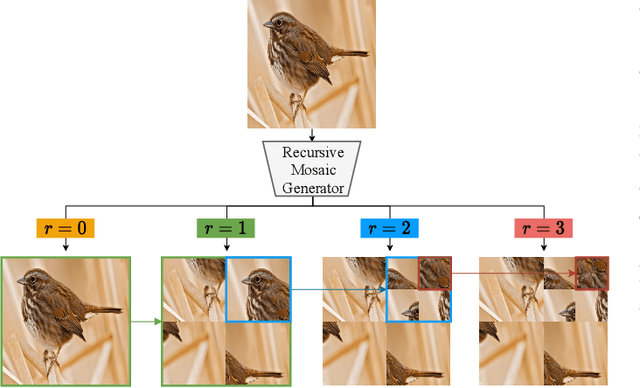
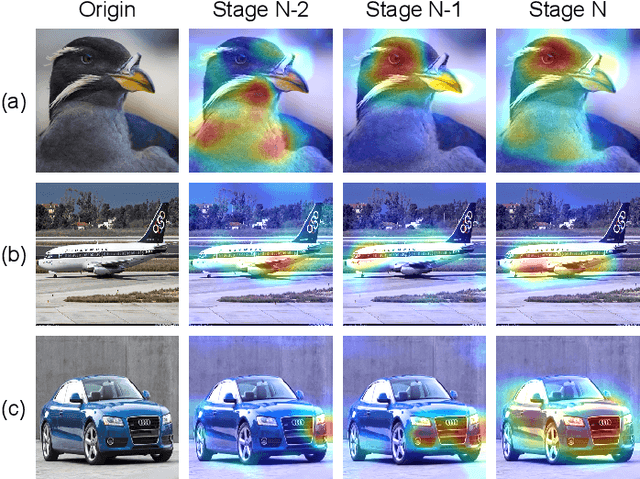
Abstract:Fine-grained Visual Classification (FGVC) aims to identify objects from subcategories. It is a very challenging task because of the subtle inter-class differences. Existing research applies large-scale convolutional neural networks or visual transformers as the feature extractor, which is extremely computationally expensive. In fact, real-world scenarios of fine-grained recognition often require a more lightweight mobile network that can be utilized offline. However, the fundamental mobile network feature extraction capability is weaker than large-scale models. In this paper, based on the lightweight MobilenetV2, we propose a Progressive Multi-Stage Interactive training method with a Recursive Mosaic Generator (RMG-PMSI). First, we propose a Recursive Mosaic Generator (RMG) that generates images with different granularities in different phases. Then, the features of different stages pass through a Multi-Stage Interaction (MSI) module, which strengthens and complements the corresponding features of different stages. Finally, using the progressive training (P), the features extracted by the model in different stages can be fully utilized and fused with each other. Experiments on three prestigious fine-grained benchmarks show that RMG-PMSI can significantly improve the performance with good robustness and transferability.
Dilated Fully Convolutional Neural Network for Depth Estimation from a Single Image
Mar 12, 2021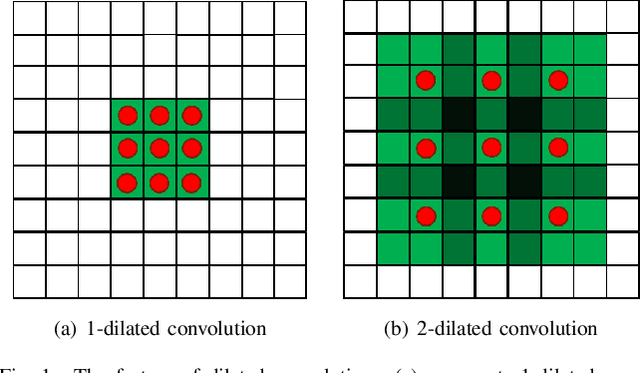
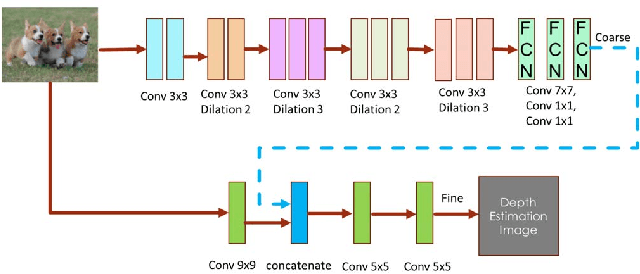
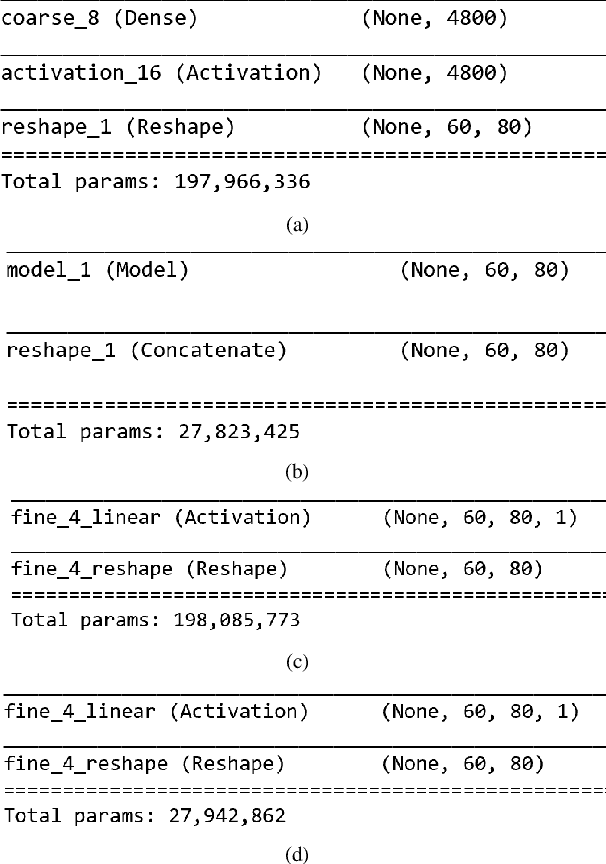
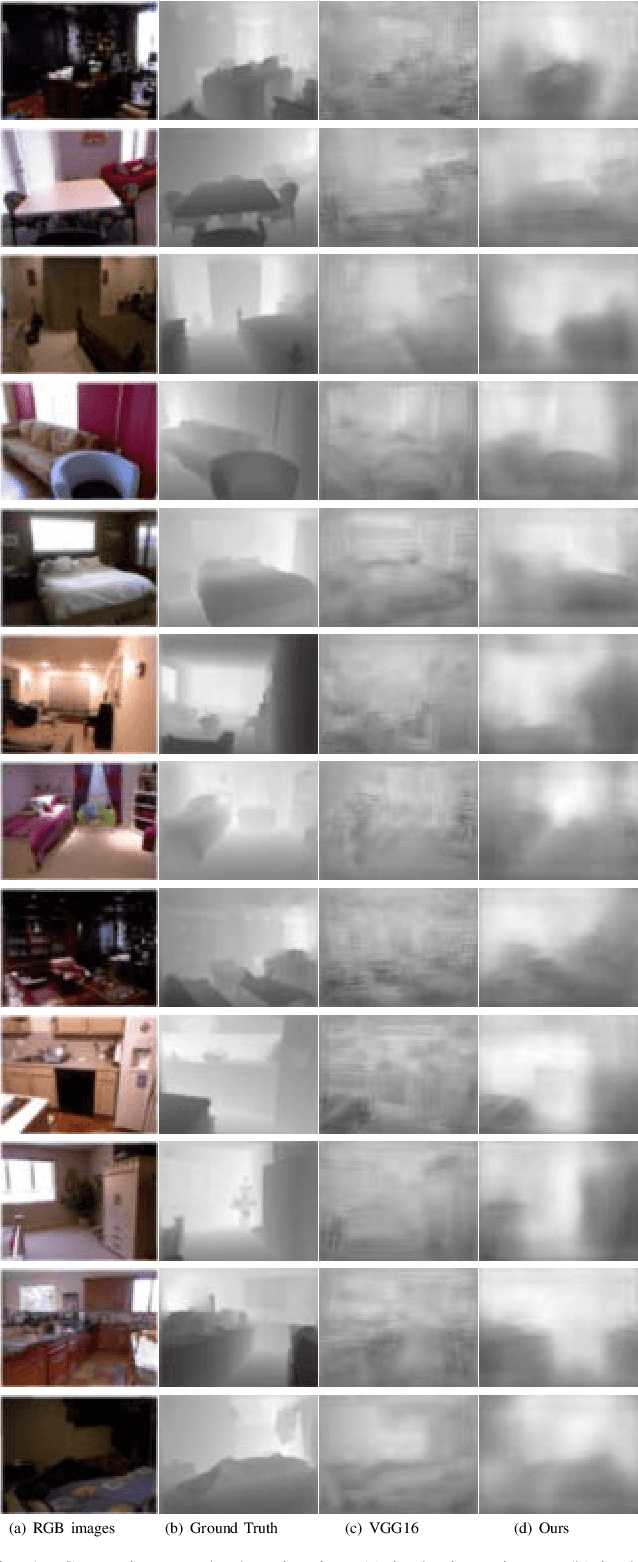
Abstract:Depth prediction plays a key role in understanding a 3D scene. Several techniques have been developed throughout the years, among which Convolutional Neural Network has recently achieved state-of-the-art performance on estimating depth from a single image. However, traditional CNNs suffer from the lower resolution and information loss caused by the pooling layers. And oversized parameters generated from fully connected layers often lead to a exploded memory usage problem. In this paper, we present an advanced Dilated Fully Convolutional Neural Network to address the deficiencies. Taking advantages of the exponential expansion of the receptive field in dilated convolutions, our model can minimize the loss of resolution. It also reduces the amount of parameters significantly by replacing the fully connected layers with the fully convolutional layers. We show experimentally on NYU Depth V2 datasets that the depth prediction obtained from our model is considerably closer to ground truth than that from traditional CNNs techniques.
 Add to Chrome
Add to Chrome Add to Firefox
Add to Firefox Add to Edge
Add to Edge